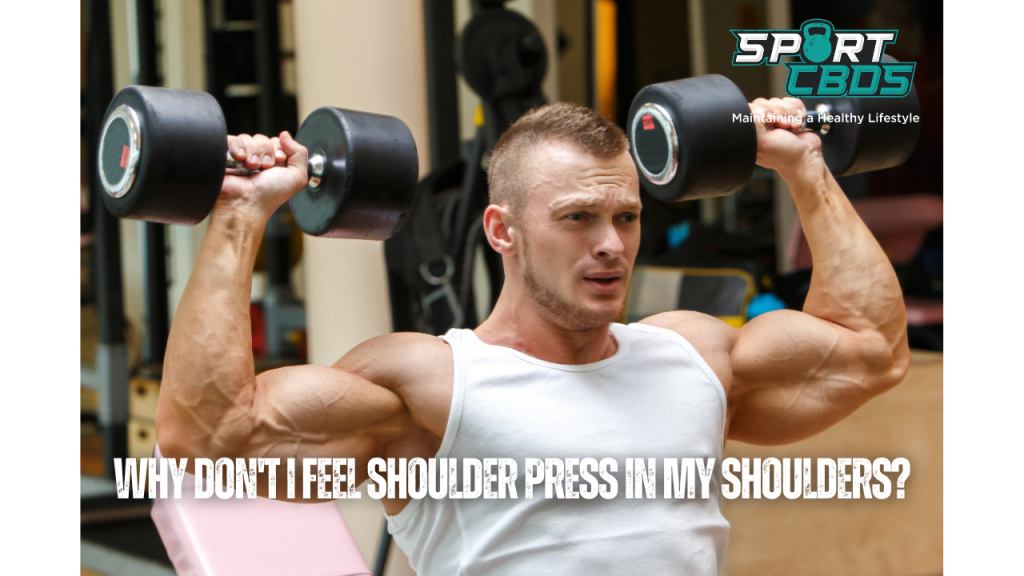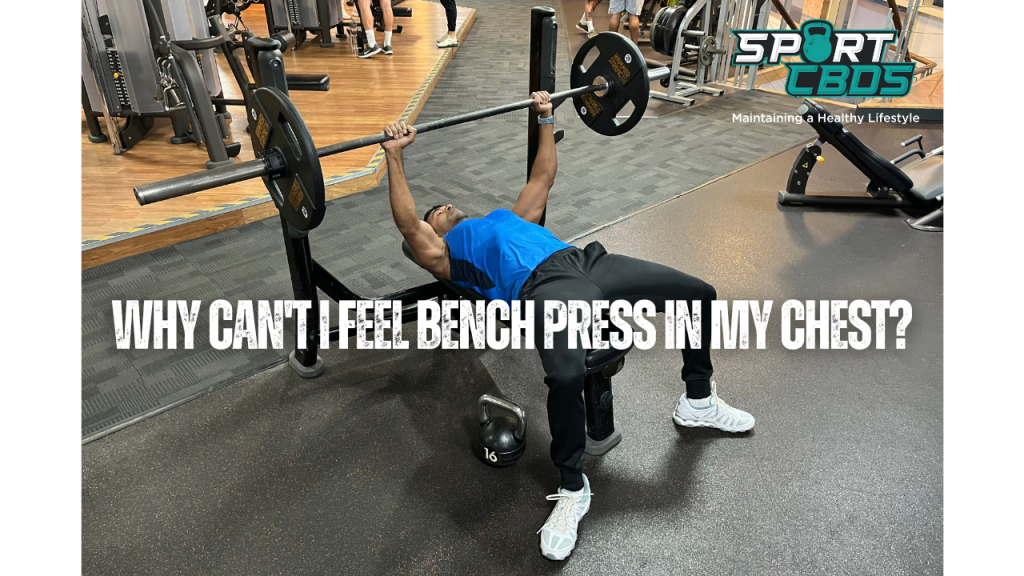
Unlocking the Mystery: Why Don’t I Feel Shoulder Press in My Shoulders?
The shoulder press is a foundational exercise in strength training, targeting the deltoid muscles of the shoulder.
As with many exercises, the shoulder press is often misunderstood, especially when it comes to where one should “feel” the movement.
A common misconception is that if you’re doing a shoulder press, you should only feel it in your shoulders. However, the body’s mechanics are more intricate than that.
Why Don’t I Feel Shoulder Press in My Shoulders?
The sensation of not feeling the shoulder press predominantly in the shoulders can be attributed to several factors. Firstly, the shoulder press is a compound movement that engages not just the deltoids, but also other muscles like the lats, serratus anterior, and the core. The lats, for instance, act as stabilizers during the press, especially during the eccentric or lowering phase. If these muscles are weak or tight, they might be more pronouncedly activated, leading to a sensation in areas other than the shoulders. Additionally, the serratus anterior, a muscle group wrapping around the rib cage, plays a pivotal role in shoulder movements. Due to its location and function, any soreness or activation here can be mistakenly attributed to the lats. Thus, while the shoulder press targets the deltoids, the involvement of other muscles and any existing imbalances can lead to the feeling being distributed beyond just the shoulders.
Understanding the Role of Lats in Pressing Movements
When we talk about pressing movements, especially the shoulder press, it’s essential to understand the role of the latissimus dorsi, commonly known as the lats. These are broad, flat muscles on each side of the mid-back, stretching to the sides and behind the arm.
Lats as Stabilizers: The lats play a crucial role as stabilizers in most pressing movements. When you’re pushing a weight overhead, such as in a shoulder press, your lats help stabilize your upper body and ensure a smooth, controlled movement. They act as a foundation, allowing other muscles, like the deltoids, to exert force and lift the weight.
Eccentric Part of the Lift: The eccentric phase of any exercise is when the muscle lengthens under tension. In the context of the shoulder press, this is when you’re lowering the weight back down. During this phase, the lats are actively engaged, controlling the descent of the weight and preventing it from dropping too quickly. This engagement can lead to the sensation of “feeling” the exercise in the lats, especially if they are undertrained or fatigued.
Misconception of Pushing Exercises: It’s a common belief that pushing exercises, like the shoulder press or bench press, only target the front muscles, like the chest or shoulders. However, this isn’t the case. As we’ve discussed, the lats are actively involved in these movements, even if they aren’t the primary muscles being worked. Recognizing this can help individuals understand their body better and adjust their workouts for a more balanced and comprehensive training regimen.
The Core’s Involvement in Shoulder Press
The shoulder press, while primarily targeting the deltoids, is a compound movement that engages multiple muscle groups. One of the most overlooked yet essential components in this exercise is the core.
Definition of the Core Muscles: The core isn’t just your abs. It’s a complex series of muscles that includes everything except your arms and legs. It encompasses your abs, obliques, lower back, and even muscles like the pelvic floor. These muscles work in harmony to stabilize the spine, pelvis, and shoulder girdle, creating a solid base for producing power, transferring energy, and moving the body.
Activation During Shoulder Presses: When you press a weight overhead, your core muscles engage to keep your body stable and upright. This stabilization prevents unnecessary swaying or arching of the back, which could lead to injury. As you push the weight up, your core tightens to counteract the force and maintain balance.
Connection with Lats, Traps, and Other Core Muscles: The lats and traps, while not strictly “core” muscles, play a significant role in stabilizing the upper body during the shoulder press. The lats help control the descent of the weight, while the traps support the upward push. These muscles, in conjunction with the core, ensure a smooth, controlled movement throughout the exercise.
Related: The Great Debate: Is It Ok To Train Shoulders Before Chest Day?
Weak Lats and Their Impact
The latissimus dorsi, or lats, are among the most influential muscles in the back. However, they’re often overshadowed by the more “showy” muscles.
- Pushing vs. Pulling Imbalance: Many fitness enthusiasts prioritize pushing exercises like bench presses and shoulder presses over pulling movements like rows or pull-ups. This can lead to an imbalance where the chest and shoulders become overdeveloped compared to the back.
- Strengthening the Lats: Strengthening the lats is crucial for a balanced physique and to support pushing movements. Strong lats can improve posture, enhance shoulder stability, and even boost the amount of weight you can press overhead.
- The “Show” Muscles Drawback: While muscles like the biceps and chest are often the focus for many aiming for an aesthetic physique, neglecting the lats can lead to imbalances and potential injuries. A well-rounded fitness routine should give equal importance to all muscle groups, ensuring functional strength and a harmonious physique.
Tight Lats: Causes and Solutions
Latissimus dorsi, commonly known as the lats, are the broad muscles that span the length of the back, from the pelvis to the shoulders. Tightness in these muscles can lead to a range of issues, from poor posture to reduced range of motion.
Modern Lifestyle’s Impact: Our contemporary lifestyle, characterized by prolonged sitting and hunching over devices, often results in tight lats. This sedentary behavior can shorten and stiffen the lats, leading to discomfort and limited mobility.
Foam Rolling and Other Techniques: Foam rolling, a form of self-myofascial release, is a popular method to alleviate lat tightness. By rolling the lats on a foam roller, one can break up muscle knots and increase blood flow to the area. Additionally, static stretching and dynamic movements can also help in lengthening and loosening the lats.
The Need for Regular Maintenance: Just as we maintain our cars or homes, our bodies also require regular upkeep. Incorporating stretching and foam rolling into a daily routine can prevent the onset of tightness and ensure the lats remain supple and functional.
The Serratus Anterior: A Common Culprit
When discussing muscles related to the shoulder and upper back, the serratus anterior often goes unnoticed. However, its role is vital for proper shoulder function and overall upper body health.
- Introduction to the Serratus Anterior: Located on the side of the chest, wrapping around the rib cage, the serratus anterior muscles play a pivotal role in scapular movement and stabilization.
- Role in Arm and Shoulder Movements: These muscles are responsible for the protraction of the scapula, meaning they help move the shoulder blades forward and around the rib cage. This action is crucial for movements like pushing and reaching.
- Strengthening the Serratus Anterior: To ensure the serratus anterior muscles are strong and functional, exercises like scapular push-ups, wall slides, and serratus punches can be incorporated into one’s routine. Regularly engaging and strengthening these muscles can prevent issues like winged scapula and ensure optimal shoulder health.
Grip Strength and Shoulder Press
Grip strength plays a pivotal role in exercises like the shoulder press. A strong grip stabilizes the weight, ensuring better control and more effective muscle activation throughout the movement.
When grip strength is optimal, it allows for a more direct and efficient transfer of force from the primary muscles, like the deltoids, to the weight being lifted. This can enhance the sensation in the shoulders during the press.
A study has shown that grip strength can influence overall upper body strength and muscle activation. For those looking to improve their grip strength, tools like the hand grip strengthener can be beneficial.
Additionally, incorporating products from Sport CBDs can aid in muscle recovery and overall athletic performance, further optimizing exercises like the shoulder press.
Related: Decoding the Best Order: Shoulder Press or Lateral Raise First?
FAQs
In the journey to mastering the shoulder press, several questions often arise. Based on popular queries, here are some frequently asked questions and their answers:
How do you activate shoulders in shoulder press?
Activating the shoulders in a shoulder press involves ensuring proper form and mind-muscle connection. Begin with a warm-up to increase blood flow to the deltoids. When performing the press, focus on pushing through the shoulders, keeping the elbows slightly in front of the barbell or dumbbells. Visualize the deltoids contracting and relaxing throughout the movement. Using lighter weights initially can help in establishing this connection.
Why can I barely shoulder press?
Struggling with the shoulder press can be due to several reasons:
Weak deltoids or supporting muscles: If the primary and secondary muscles involved are not strong enough, pressing overhead can be challenging.
Poor technique: Incorrect form can hinder performance and reduce the weight one can lift.
Lack of mobility: Restricted range of motion in the shoulders or upper back can limit the ability to press effectively.
Why can’t I shoulder press without pain?
Experiencing pain during a shoulder press can be a sign of:
Poor form: Incorrect technique can place undue stress on the joints and muscles.
Underlying injuries: Pre-existing conditions like rotator cuff injuries or shoulder impingements can be aggravated by pressing movements.
Overtraining: Not allowing adequate recovery can lead to muscle strains and pain.
How do you fix a weak shoulder press?
Improving a weak shoulder press involves:
Strengthening the deltoids and supporting muscles: Incorporate isolation exercises like lateral raises and front raises.
Improving technique: Consider working with a trainer to ensure proper form.
Increasing mobility: Incorporate stretching and mobility exercises to enhance the range of motion in the shoulders.
Progressive overload: Gradually increase the weight while maintaining good form to build strength over time.
Final Thoughts…
The shoulder press, while seemingly straightforward, involves intricate muscle dynamics and requires a keen understanding of one’s body. From the role of the lats and serratus anterior to the importance of the core, every aspect plays a crucial part in executing the perfect press.
Recognizing and addressing common issues, whether they’re related to technique, strength imbalances, or mobility restrictions, is essential.
Ultimately, understanding muscle involvement in exercises not only enhances performance but also ensures longevity in one’s fitness journey.
Do you not feel shoulder press in your shoulders? Have our tips been beneficial to your training? We’d love to hear your feedback, so please share your thoughts in the comments section below.
If you’re a sports enthusiast who utilizes CBD for optimal recovery after intense workouts, then you’ve found your tribe. Welcome to Sport CBDs, where we push our limits in training and prioritize recovery in the most effective way possible.
We regularly share workout routines on our YouTube channel and offer a range of health and fitness products designed to give you that competitive edge.
Why not explore the high-quality CBD products we proudly feature on our site? Visit the Sport CBDs Store by clicking here. In addition to CBD, we also offer an array of fitness clothing and yoga accessories to complement your active lifestyle.
Until next time, we wish you the best in your fitness journey. Remember, your progress is our passion. Stay strong and keep pushing!

Lee
Founder – Sport CBDs
Featured Image Attribution – Image by Racool_studio on Freepik

